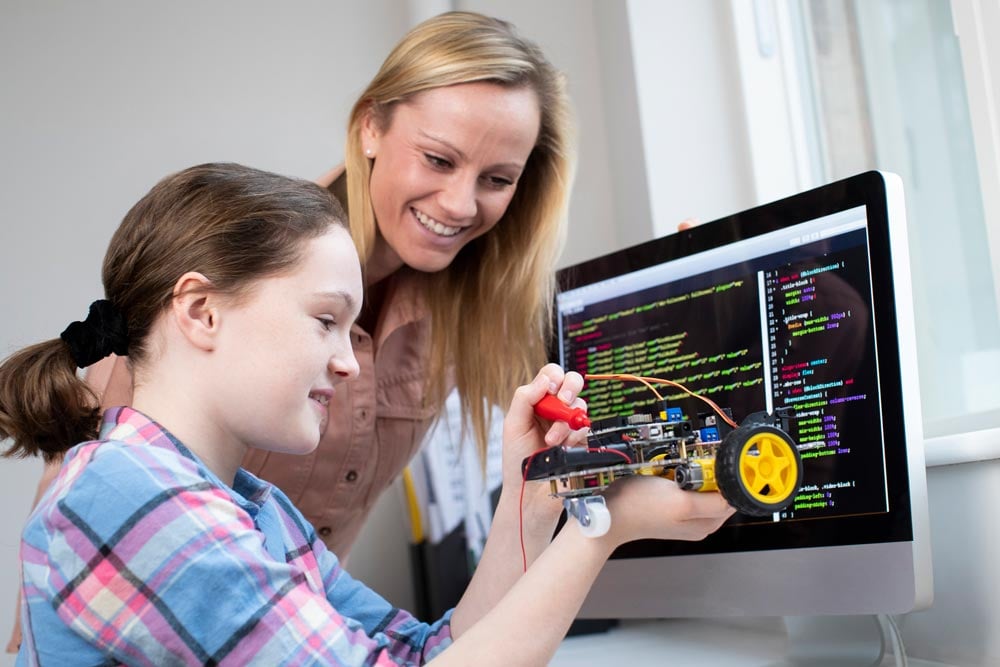Explore NGSS-aligned STEM science kits designed for the classroom
STEM science kits further enhance the eye-opening experience of learning STEM in the classroom. Covering numerous science topics from the basic building blocks of engineering to complex mechanics, physics, and robotics, STEM science kits for the classroom provide a single-source solution for educators and administrators alike.
What Is a STEM Science Kit?
A STEM Science Kit is a comprehensive learning tool that includes STEM science activities with all the tools, components, and instructions to complete each activity. Science kits can range from at-home activity kits to all-in-one curriculum solutions across multiple grade levels.
At Kid Spark Education, we design science-based STEM programs with all-inclusive STEM science kits that include complete units of instruction, lesson plans, assessments, STEM activities, activity components, and professional learning for educators. From Pre-K through 8th grade, our comprehensive STEM programs progressively build STEM fluency in students, from basics of spatial reasoning and engineering through coding, robotics, and complex mechanical engineering.
3 Benefits of STEM Science Kits in the Classroom
Students of all grade levels benefit from regular interactions and instruction in science, technology, engineering, and mathematics. When these concepts are introduced through the structure of STEM science kits, students progressively build STEM fluencies that can positively impact the rest of their lives.
Here are just a few of the many benefits students receive from comprehensive STEM Science Kits:
- Hands-On Learning Experiences
STEM science kits provide the perfect opportunity for students to engage in interactive hands-on learning experiences with their peers. The collaborative nature of building, engineering, and designing solutions as a team through creative thinking makes STEM activities fun and exciting, while also helping students retain more information and apply these STEM concepts to the real world.
- Multi-Disciplinary Academic Success
STEM science kits help students succeed in school subjects and studies outside of science. STEM education builds critical thinking, problem-solving, logical reasoning, teamwork, and many other skills that positively impact all of a student’s studies and contribute to their academic success.
- Building STEM Identity
STEM identity and STEM confidence are closely intertwined. How students think of themselves in relation to science, technology, engineering, and mathematics can dramatically impact their future success in these school subjects…and in their careers. In short, the effects of positive or negative STEM identity can follow a student for the rest of their lives.
That’s why building STEM identity and STEM confidence early is essential to closing the equity gap in STEM and empowering students to be successful in whatever avenues they choose in the future.
How to Choose a STEM Science Kit for Your Classroom
To find the right STEM science kit for your students, additional considerations should be reviewed beyond grade level and budget. While budget is a considerable factor in finding a science kit that best fits your classroom, additional funding options are available to make STEM education more accessible such as Kid Spark Education’s STEM Equity Grants or the federally-funded EANS program.
Here are a few additional factors to consider when choosing your classroom’s STEM science kit:
- NGSS-Aligned Curriculum
The Next Generation Science Standards (NGSS) are science curriculum standards for what students should know at each grade level K-12. These research-based standards serve as a helpful guide for educators to make sure their students are receiving a comprehensive science education.
The core concepts of NGSS include three dimensions to learning science: Crosscutting Concepts (understanding connections between science subjects); Science and Engineering Practices (practicing the scientific processes of inquiry and investigation); Disciplinary Core Ideas (the essential concepts of science across multiple scientific disciplines).
Choosing a STEM science kit that aligns with the three dimensions of NGSS, offers a more comprehensive learning experience for your students. (For more information on how Kid Spark’s elementary and middle school STEM kits support NGSS, read this article.)
- Convergent and Divergent Learning
Convergent and divergent learning are two critical components of a comprehensive STEM science kit. Where convergent learning helps students build familiarity with STEM concepts to be able to recall them to memory, divergent learning allows students to explore these concepts through hands-on learning experiences. Both are essential for concept retention and application in the real world.

Many STEM science kits offer divergent learning experiences: experiential learning lessons where students can explore new ideas through science activities. However, combining these activities with a science-based convergent learning curriculum gives students the vocabulary and understanding they need to apply their STEM skills in designing real-world solutions.
- Comprehensive STEM Subjects
Connecting subjects and concepts make a STEM science kit even more effective in the classroom. Science activities should introduce students to multiple fields of science itself (physical science, life science, engineering, space science, etc.), as well as connect these fields to other applied STEM subjects like applied mathematics, physics, and technology.
When students are exposed to the connections between science subjects, they have a better understanding of how these concepts interact in the real world.
STEM Science Kit for Kindergarten
STEM science kits for kindergarten should be designed to build a solid foundation of STEM skills so young students feel confident exploring STEM. This early confidence can spark their curiosity and empower them to start an impassioned journey in STEM education.
What should be included in a STEM science kit for kindergarten?
- Core STEM Fluencies
For many students, kindergarten might be the first introduction to STEM science so it’s vital to build a solid foundation in the core concepts of STEM, like spatial reasoning, logical sequencing, and creative problem-solving.
- Collaborative Learning Experiences
Kindergarten students learn so much through play. Collaborative learning experiences in STEM further enrich the hands-on learning activities of STEM science kits and help students embrace other original ideas and perspectives and learn the value of teamwork when solving problems together.
- Child-Friendly Materials
STEM can be intimidating to young students if the curriculum and program materials are not age-appropriate, especially at the introductory level of kindergarten. STEM science kits for kindergarten should be specifically designed for that age group to keep their educational experience engaging, interactive, and exciting.
At Kid Spark, our first comprehensive STEM program is designed for students Pre-K through 1st grade, with multiple units of instruction and numerous lesson plans. Here’s all that is included in Kid Spark’s Foundational Fluencies STEM program:
- Curriculum: four units of instruction with multiple lesson plans each, unit overviews, unit assessments, and printed curriculum books.
- Engineering Materials: reusable tools for the hands-on learning opportunities and creative challenges included in each lesson.
- Organizational Bin: a place to keep all printed materials and engineering materials, complete with an inventory guide that makes it easy to manage and locate all the learning materials included.
- Professional Development: online learning courses for educators to be prepared in all program materials and resources before instruction.
Learn more about our Pre-K–1st Grade STEM Program for your classroom, or explore more ideas for STEM Curriculum for Kindergarten.
STEM Science Kit for Elementary
STEM science kits for the elementary curriculum should incorporate the foundational concepts of STEM while further building students’ abilities to creatively solve problems with their own designed solutions.
What should be included in a STEM science kit for elementary?
- Understanding How STEM Concepts Work
Elementary STEM science kits should further build on the foundational STEM concepts of logical reasoning, critical thinking, and sequencing, and encourage students to jump into the engineer or scientist role of investigating why and how things work.
- Designing Solutions
Once students start to understand how STEM concepts work and how they are applied to the real world, they can start to design and engineer processes themselves. This is an empowering approach to teaching STEM as elementary students gain confidence in solving problems and approaching challenges with both knowledge and creativity.
- Accessible Curriculum
Not all students at the elementary level have previous experience or exposure to STEM. Introducing a rigid STEM science kit that is too challenging for some students, and possibly not challenging enough for others can discourage students from pursuing STEM further.
It’s important to choose a STEM science kit with a curriculum that’s accessible to all levels and all learning styles. Kid Spark’s elementary STEM program is designed as a progressive curriculum to allow students of all abilities to access STEM education and further close the STEM opportunity gap.
The Kid Spark STEM Pathways Lab is designed for elementary grades 2-5. Within multiple units of progressive instruction, students explore mechanical and structural engineering, applied mathematics, robotics, and coding. Throughout these comprehensive lessons of convergent and divergent learning, students gain confidence and independence in their ability to design their own solutions and author their own programs by using their STEM education. Here’s what’s included:
- Curriculum: five units of instruction with multiple hands-on lessons within each unit, unit overviews, unit assessments, and printed curriculum resources. (Get a sample of Kid Spark’s Elementary curriculum)
- Engineering and Robotic Materials: reusable engineering and robotic tools that include building components, articulating components, robotics, electronic components, and a robotics controller that’s compatible with most operating systems including Chromebook, macOS, and Windows.
- Organizational Bin: designed for groups of 2-4 students each, each bin includes all the material components and printed materials with an inventory and organization guide to keep materials organized and intact.
- Professional Development: educators can prepare for unit instruction and familiarize themselves with program materials and resources through the online courses provided in Kid Spark’s online learning management system.

Learn more about Kid Spark’s 2nd-5th Grade Elementary STEM Program, or read more about STEM curriculum for elementary schools.
STEM Science Kit for Middle School
STEM science kits for middle school students should seek to further challenge students in their STEM journey in fun, engaging ways while also teaching them more advanced scientific concepts.
What should be included in a STEM science kit for middle school?
- Engaging Hands-On Activities
Middle school students are still eager to engage in hands-on activities, but they must be geared toward their age group and skill level. A middle school STEM science kit should account for both grade level and the type of hands-on activities that keep middle schoolers challenged and engaged.
- Broad Range of Technologies and Scientific Subjects
More complex and advanced technologies and science subjects can be introduced at the middle school level. Intersecting science, mathematics, engineering, and technology with more challenging concepts can further build students’ STEM confidence and ability to design solutions themselves.
- Versatile Curriculum
Educational gaps from accessibility to learning styles can be further exaggerated in middle school when the curriculum becomes more challenging. It’s important to include a progressive and versatile curriculum that can accommodate students at all levels, keeping advanced students engaged while keeping students less familiar with STEM involved.

For example, Kid Spark’s elementary STEM program introduces students to robotics with lessons that are progressively designed to suit students of all experience levels and abilities. Students with little or no coding experience can participate with simple drag-and-drop coding and then later transition to text-based coding when they’re ready.
Kid Spark’s STEM Pathways Lab for grades 6-8 explores advanced structural and mechanical engineering, physics, rapid prototyping and 3D printing, computer science, and robotics. Here’s what’s included in each STEM lab kit:
- Curriculum: six units of STEM instruction with multiple hands-on lessons for each unit, creative challenge activities, unit overviews, unit assessments, and printed curriculum materials across a broad range of technologies and science subjects.
- Engineering and Robotic Materials: reusable engineering and robotic components to be used for creative challenges and lesson activities throughout the entire curriculum.
- Organizational Bin: organized lab kits designed for teams of 2-4 students with all the curriculum, engineering, and robotic components needed for all units and lessons.
- Professional Development: online learning course to empower educators in the classroom with resources to be trained in the Pathways lab program materials and curriculum.
Explore Kid Spark’s STEM Program for 6th-8th grade, or learn more about the benefits of middle school STEM labs.
How to Get Started with Kid Spark’s STEM Science Kit Programs
If you’re ready to get started with Kid Spark’s all-in-one STEM Programs, you can purchase program materials here.
Or, if you’d like to connect with the Kid Spark team to plan your STEM program, contact us today.
.png?width=1270&height=453&name=Copy%20of%20Kid%20Spark%20Logo%20(Horizontal%20-%20Full%20Color).png)